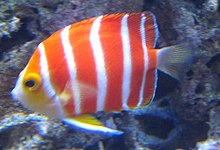Zebra angelfish
| Zebra angelfish | ||||||||||||
|---|---|---|---|---|---|---|---|---|---|---|---|---|

Zebra angelfish ( Paracentropyge multifasciatus ) |
||||||||||||
| Systematics | ||||||||||||
|
||||||||||||
| Scientific name of the genus | ||||||||||||
| Paracentropyge | ||||||||||||
| Burgess , 1991 | ||||||||||||
| Scientific name of the species | ||||||||||||
| Paracentropyge multifasciatus | ||||||||||||
| ( Smith & Radcliffe , 1911) |
The zebra angelfish or zebra duke fish ( Paracentropyge multifasciatus ) is a small marine fish from the family of angelfish (Pomacanthidae). The species occurs in the Indo-Pacific from the Cocos Islands over eastern Indonesia , the Solomon Islands and the Great Barrier Reef to the Society Islands and north over the Philippines to the Japanese Yaeyama Islands .
features
The zebra angelfish reaches a body length of 12 cm. In terms of its external shape, it differs little from the pygmy angelfish of the genus Centropyge , but in comparison to some Centropyge species it appears a bit more compact and high-backed. In contrast to the Centropyge species, which have 14 or 15 spines in the dorsal fin, it only has 13.
- Fin formula : Dorsal XIII / 17-19; Anal III / 17-18.
The black and white stripes of the species are striking ( multifasciatus = with many bands). The tip of the snout, the pelvic fins and the stripes on the anal fin are yellow.
Way of life
The zebra angelfish is relatively rare and, as it lives hidden at greater depths, it is rarely seen by divers. He lives in pairs or in small groups caves and crevices on outer reef slopes from which he is only a few centimeters away. He swims upside down near the ceiling of the cave. Animals kept in captivity tend to starve to death, suggesting a nutrition specialist .

Systematics
Zebra angelfish in 1911 by the American ichthyologists Hugh McCormick Smith and Lewis Radcliffe as Centropyge multifasciatus described and 1991 by Warren E. Burgess in the genre Paracentropyge ( Gr : "para" (παρά) = + next. Centropyge provided). The genus is monotypical to this day , but phylogenetic analyzes suggest that the Cook's angelfish ( Centropyge boylei ) and Centropyge venusta , occasionally hybridized with Paracentropyge multifasciatus , are more closely related to Paracentropyge than to the other species of the paraphyletic genus Centropyge . Some scientists therefore advocate transferring both species to the Paracentropyge genus .
literature
- Roger C. Steene: Butterfly and Angelfish, Volume 1 . Mergus Verlag, 1977, ISBN 3-88244-001-5
Individual evidence
- ^ HM Smith & L. Radcliffe (1911): Descriptions of three new fishes of the family Chaetodon from the Philippine Islands. Scientific results of the Philippine cruise of the Fisheries steamer "Albatross," 1907-1910 .-- No. 9.] . Proceedings of the United States National Museum v. 40 (no. 1822): 319-326.
- ^ Warren E. Burgess (1991). Two new genera of angelfishes, family Pomacanthidae. Tropical Fish Hobbyist, March 1991: 68-70.
- ↑ Centropyge venusta on Fishbase.org (English)
- ↑ Michelle Gaither, Jennifer K. Schultz, David R. Bellwood, Richard L. Pyle, Joseph D. DiBattista, Luiz A. Rocha, Brian W. Bowen: Evolution of pygmy angelfishes: recent divergences, introgression, and the usefulness of color in taxonomy. Molecular Phylogenetics and Evolution, February 2014, doi: 10.1016 / j.ympev.2014.01.017
Web links
- Paracentropyge multifasciatus on Fishbase.org (English)
- Paracentropyge multifasciata inthe IUCN 2013 Red List of Threatened Species . Posted by: Pyle, R. & Myers, R., 2010. Retrieved February 6, 2014.